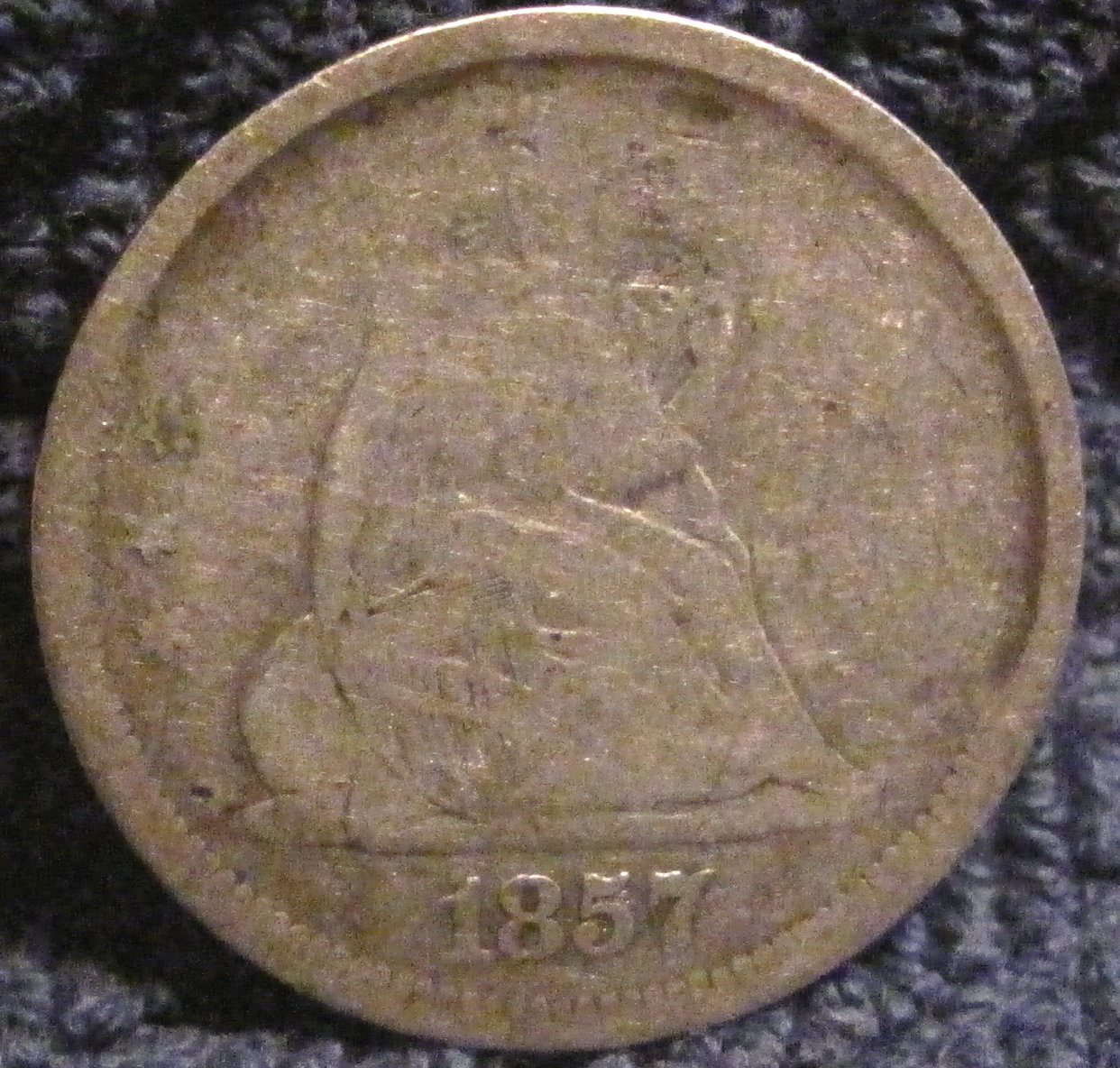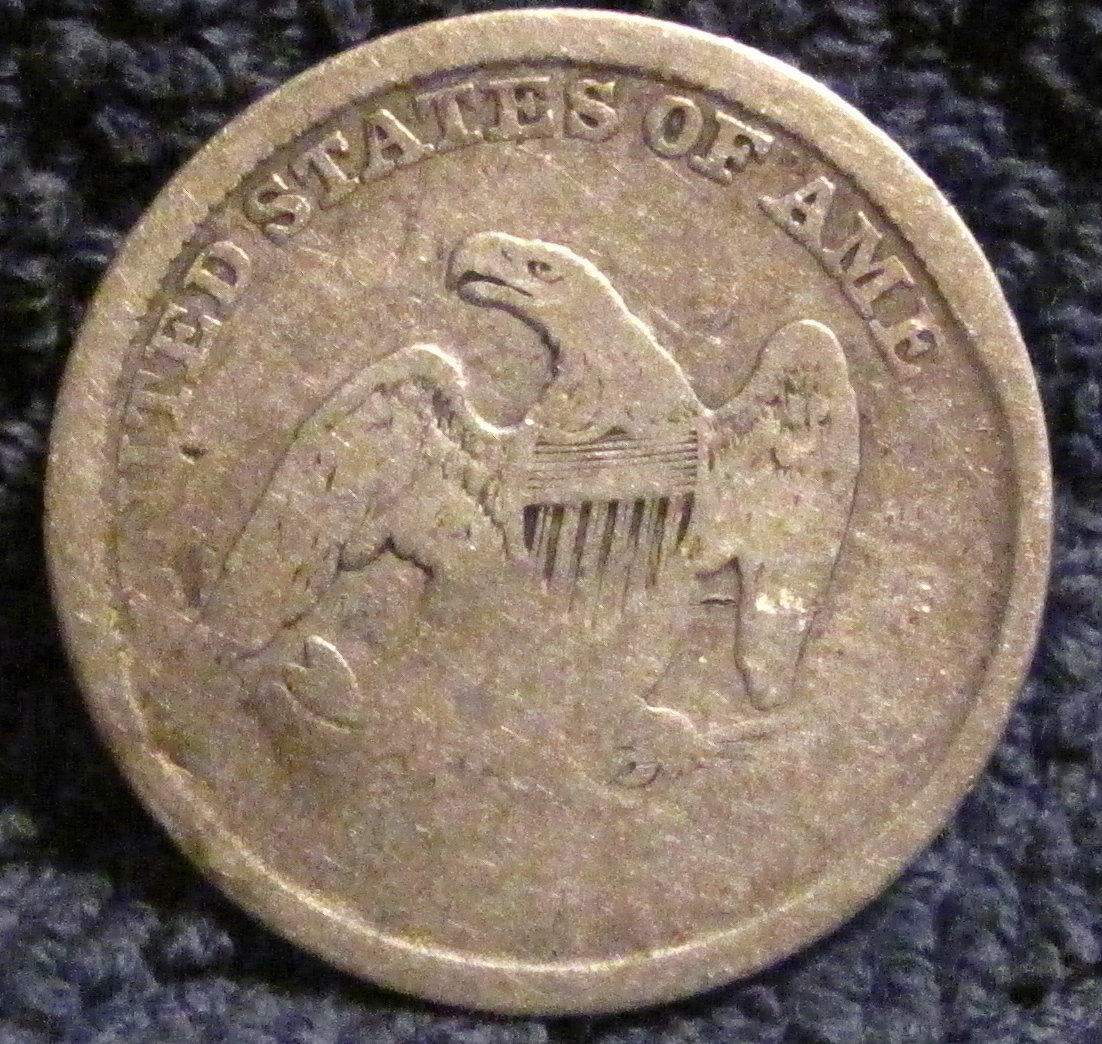What's happened to this quarter? Can't be all PMD.
 fastfreddie
Posts: 2,904 ✭✭✭✭✭
fastfreddie
Posts: 2,904 ✭✭✭✭✭
Besides the wear...sorry for the crappy photo's. I thought it was interesting. The missing (or wore off) detail is in the same area Obverse to Reverse. Thoughts?

It is not that life is short, but that you are dead for so very long.
0
Comments
Perhaps it is was used as a wedge or to balance a table.
Best place to buy !
Bronze Associate member
good question
Maybe, but note the existence of the rim. How could the detail wear off but the rim still exist. This is not the usual wear pattern IMO.
That's for sure. Don't know if the mystery can be solved due to the wear.
Struck on tapered planchet. If you check the weight it will be obviously low even beyond the effect of the wear. Nice example.
I don't have a gram scale, I will try and weigh...
How would the rim be so high and sharp in that case? (Not saying it isn't a TP, but I just wasn't aware how this would work).
I noticed the lack of denticles in the worn area and that the rim is narrower in that area compared to the balance of rim.
I agree with Jonathan. The rim is upset on these coins before the strike, so even though the planchet was thin, the rim would be well struck.
I have an 1857 quarter somewhere with a similar error but with a much smaller weakly struck section, if I can find pics I will add them to the thread.
Sean Reynolds
"Keep in mind that most of what passes as numismatic information is no more than tested opinion at best, and marketing blather at worst. However, I try to choose my words carefully, since I know that you guys are always watching." - Joe O'Connor
Agree tapered thin planchet.
Could be misaligned dies, as well.
What is now proved was once only imagined. - William Blake
Shrunken head. It's voodoo. Common voodoo stuff.
It's a Pre-Civil War magicians coin called the "Vanishing Liberty/Eagle'
Think back to the 1850's and note how crude the US Mints were at that time for the production runs of common currency. Surprised we don't see more of these types of anomalies.
"Keep your malarkey filter in good operating order" -Walter Breen
The wear definitely makes this one tough. However...
I tend to agree. Most tapered planchets, especially on more modern coinage, don't have such strong proto-rims (the one applied by the upsetting mill). But, after looking at some off-center seated coinage, I see that many of them also have very strong proto-rims. So, this may not have been a consistent outcome for the entire span of seated quarter production, but it did happen. The thinness of the planchet in this area may also accentuate the proto-rim.
Additionally I located this tapered planchet on seated quarter error. (I have no relation to the seller or stake in its sale). This one, due to the existence of more detail, is easily determined to be a true mint error and we can see some similarities between it and the OP's coin:
As @jonathanb stated, you should likely be able to observe a weight difference from a normal coin with this much wear.
Not likely. On a vertical die misalignment we would observe two things: 1) Missing details on one end of the coin, 2) very strong design rim or rim fin and "deep" strike" on the other end (only on one side of the coin, most likely the obverse). The latter of these two cannot be observed on this coin.
Though, 50 years of circulation could erase this effect....... so maybe you're right.
I agree with the tapered planchet determination....and the OP indicates he can see a difference in the edge thickness...Cheers, RickO
The 19th Century coins with wide, denticled rims needed wide upset rims on the planchets to fill out those rims, as compared to the skinny rims normal today.
To confirm CaptHenway's comment, Franklin Peale's upsetting machines were designed to create a somewhat higher rim than later versions. The high, wide coin rim was intended to better protect the design and keep silver coins in circulation longer.
Die-trial-setting-up with extra wear on the coin. the date shows if you look carefully enough.
No Gram scale but I measured with a micrometer and it measured a rim thickness of 56 thousandths on the non-worn (as much) rim side to 44 thousandths. Also, on the thin rim side the reeding is present, but faint.
Freddie
Thx for posting it. I learned a lot on this thread.
Amazing to find and ID that error after so many years and so much wear.
Received my gram scale in the mail today so I weighted my quarter. It's 5.3 grams so about 1 gram light (6.22). Taking into account for wear, the tapered planchet theory seems to be spot on!
Thanks guys! cool error!
Freddie
Congratulations! That is an incredible find.
I just saw your link; definitely the same type of error IMO...Thanks!
"Additionally I located [this tapered planchet on seated quarter error. (I have no relation to the seller or stake in its sale). This one, due to the existence of more detail, is easily determined to be a true mint error and we can see some similarities between it and the OP's coin:"
As promised, I found my 1857 seated quarter with a tapered planchet over the weekend, here are a couple of cell phone pics.
Sean Reynolds
"Keep in mind that most of what passes as numismatic information is no more than tested opinion at best, and marketing blather at worst. However, I try to choose my words carefully, since I know that you guys are always watching." - Joe O'Connor
And some are just the opposite.
https://www.ebay.com/itm/MINT-ERROR-1835-CAPPED-BUST-HALF-PCGS-IMPRESSIVE/391992612624?hash=item5b44949710:g:OOQAAOSwRbtaCi1b